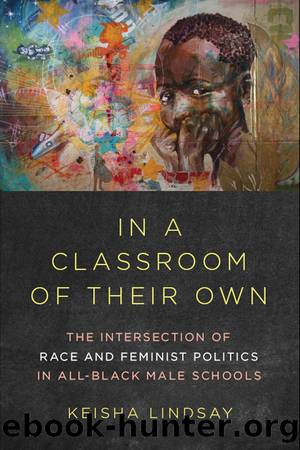In a Classroom of Their Own by Keisha Lindsay

Author:Keisha Lindsay [Lindsay, Keisha]
Language: eng
Format: epub
Tags: Social Science, General, Feminism & Feminist Theory, Ethnic Studies, American, African American & Black Studies, Education, Educational Policy & Reform
ISBN: 9780252050404
Google: qMllDwAAQBAJ
Publisher: University of Illinois Press
Published: 2018-07-02T05:52:33+00:00
4
Building Progressive Coalitions around Experience-Based Politics
In 1992 four panelists and a moderator gathered to discuss the effort to open ABMSs. At the time of the roundtableâofficially titled âAfrican American Male Immersion Schools: Segregation? Separation? or Innovation?â (AMIS)âparents, educators, and government officials had established or were in the process of proposing numerous publicly funded ABMSs, including Detroit's Malcolm X Academy, Milwaukee's African-American Immersion Schools, and New York City's Ujamaa Institute (Whitaker 1991; Watson and Smitherman 1996). The official summary of the roundtable suggests that its co-sponsors, the National Urban League (NUL) and the Carnegie Corporation of New York (CCNY), were very much aware of this context:
The purpose of this roundtable is to provide educators and professionalsâ¦an opportunity to explore the background of educational initiatives for Black males. These gender and race specific academic programs represent efforts to meet the academic and cultural needs of African American males. The [roundtable] also examines the controversy surrounding the development of these schools and recent judicial decisions that have ruled against these models or caused them to be modified. Roundtable panelists examine a school model which many feel can have a significant impact on the positive development of school age African American males. A second goal of this roundtable is to present a balanced perspective on these school models and provide the opportunity for the viewer to make informed decisions on immersion school proposals. (NUL 1992, iii)
While it might seem counterintuitive to focus on a roundtable that occurred so early in the history of ABMSsâjust a year after the first such school opened in Detroitâdoing so is useful and relevant on a number of other fronts. The AMIS roundtable is one of the earliest and remains one of the few public venues in which black male supporters and feminist critics of ABMSs have met to discuss the perils and promise of such schools.1 Its duration (the typed transcript runs twenty-five pages) and relatively small number of participants also give it a depth and scope that is uncommon in other gatherings about ABMSs. Furthermore, unlike other workshops, panels, and forums about separate schools for black boys, participants in the AMIS roundtable are evenly split between supporters and critics. As a result, they do not express concerns about being outnumbered or about the objectivity of the proceedings. Nor is there any opportunity for those with the majority view to engage only with each other. And last, participants in the roundtable reflect the diversity of the educators, lawmakers, advocacy groups, and civil rights organizations, such as the National Urban League, the American Civil Liberties Union, and the National Organization of Women Legal Defense and Education Fund, that have been active, from the very beginning, in the ongoing debate about single-gender schooling for black boys.
Most important, the AMIS roundtable provides a point of departure for envisioning the circumstances in which black male supporters of ABMSs might help to forge antiracist as well as feminist coalitions among black men, black women, and other social groups. Of course, any suggestion that
Download
This site does not store any files on its server. We only index and link to content provided by other sites. Please contact the content providers to delete copyright contents if any and email us, we'll remove relevant links or contents immediately.
The Art of Coaching Workbook by Elena Aguilar(48031)
Trainspotting by Irvine Welsh(20042)
Twilight of the Idols With the Antichrist and Ecce Homo by Friedrich Nietzsche(17702)
Fangirl by Rainbow Rowell(7825)
Periodization Training for Sports by Tudor Bompa(7322)
Change Your Questions, Change Your Life by Marilee Adams(6635)
This Is How You Lose Her by Junot Diaz(5753)
Grit by Angela Duckworth(4728)
Red Sparrow by Jason Matthews(4654)
Asking the Right Questions: A Guide to Critical Thinking by M. Neil Browne & Stuart M. Keeley(4564)
Paper Towns by Green John(4163)
Room 212 by Kate Stewart(4099)
Ken Follett - World without end by Ken Follett(3968)
The Sports Rules Book by Human Kinetics(3581)
Housekeeping by Marilynne Robinson(3395)
The Motorcycle Diaries by Ernesto Che Guevara(3325)
Introduction to Kinesiology by Shirl J. Hoffman(3297)
Exercise Technique Manual for Resistance Training by National Strength & Conditioning Association(3285)
Double Down (Diary of a Wimpy Kid Book 11) by Jeff Kinney(3267)
